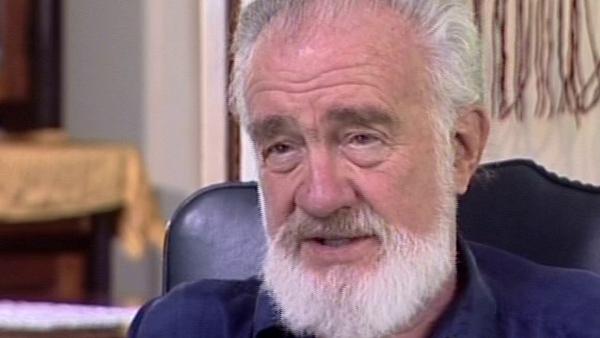NEXT STORY

Who was Magda Goebbels?
RELATED STORIES

NEXT STORY

Who was Magda Goebbels?
RELATED STORIES


|
Views | Duration | |
|---|---|---|---|
| 41. Himmler - the worst fuddy-duddy that ever lived | 194 | 02:45 | |
| 42. Max Frisch's Biedermann and the Firebugs | 266 | 05:02 | |
| 43. Creating Magda Goebbels' lines | 164 | 02:14 | |
| 44. Who was Magda Goebbels? | 292 | 02:37 | |
| 45. Joseph and Magda Goebbels were both unfaithful | 249 | 03:47 | |
| 46. The use of new verse forms in The Fuehrer Bunker | 105 | 02:22 | |
| 47. The music of poetry is its meaning | 185 | 04:59 | |
| 48. The first edition of The Fuehrer Bunker | 109 | 02:20 | |
| 49. Critics labeled The Fuehrer Bunker pro-Nazi | 147 | 00:46 | |
| 50. Negative reactions to The Fuehrer Bunker | 132 | 01:06 |


More and more, you know, as I got more and more poems I thought well okay, I've got to try to make a whole thing out of this and… and maybe try to take it through the whole period in the bunker when… when Hitler has... has come in from — what was it — the Wolfsschanze or something like that, where he had his headquarters, and now is under the chancellory in… in these underground tunnels, which incidentally are much more… much more extensive than anybody had had any idea for even 20 years after the War, nobody had any idea how… how… they had practically a whole underground city under there. And I decided okay, let's see if I can take it through that whole period, up to the… up to the surrender, and add more and more characters and.... Mag… Magda Goebbels, I didn't mention her earlier, she… she all sings in French, in very elaborate French love poem form… love poem form, you know, for lying in love. So… so, everything she was doing — as I saw it — was a sort of parallel to the things that the Nazis as rulers were doing. I mean clearly… clearly Goeb… Goebbels felt the important thing is to keep saying the same lie over and over, louder and louder. Well, she does the same thing, she has these repetitious French love poems where… roundelays and triplets and I don't know, I forget the names of all of them, but anyway, she’s using all of them — villanelles — she doesn't do a sestina because she had six children there and so they get to do the sestina, there's six parts in other words. But yeah, and… and you know pretty soon I had almost all the major characters that I wanted to… to deal with.
American poet WD Snodgrass, entered the world of poetry with a bang winning several awards, including the Pulitzer Prize, for his first collection of poetry, Heart's Needle. A backlash followed his controversial fifth anthology “The Fuehrer Bunker”, but in recent years these poems have been reassessed and their importance recognised.
Title: Creating Magda Goebbels' lines
Listeners: William B. Patrick
William B. Patrick is a writer and poet who lives in Troy, New York. Among his work are the poetry volumes "We Didn't Come Here for This" and "These Upraised Hands", the novel "Roxa: Voices of the Culver Family" and the plays "Rescue" and "Rachel's Dinner". His most recent work is the non-fiction book "Saving Troy", based on the year he spent following the Troy Fire Department.
Mr. Patrick has been Writer-in-Residence at the New York State Writers Institute and has taught at Old Dominion University, Onondaga Community College, and Salem State College, and workshops in Screenwriting and Playwriting at the Blue Ridge Writers Conference in Roanoke, Virginia. He has received grants from the Academy of American Poets, the National Endowment for the Arts, the Massachusetts Artists Foundation, and the Virginia Commission for the Arts.
Tags: Wolfsschanze, Wolf's Lair, World War II, Nazis, Magda Goebbels, Adolf Hitler, Joseph Goebbels
Duration: 2 minutes, 15 seconds
Date story recorded: August 2004
Date story went live: 24 January 2008